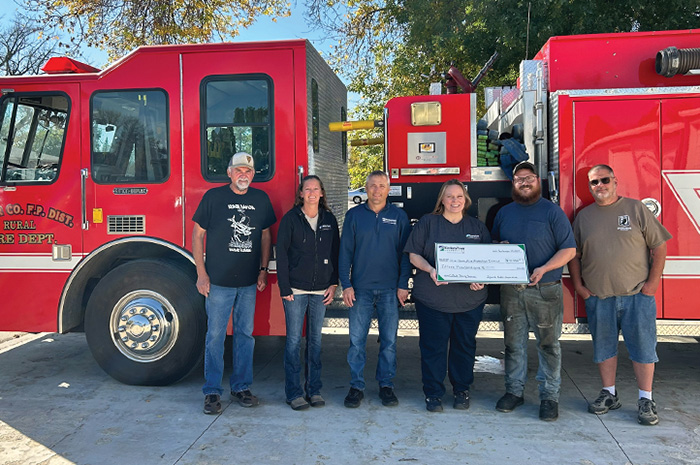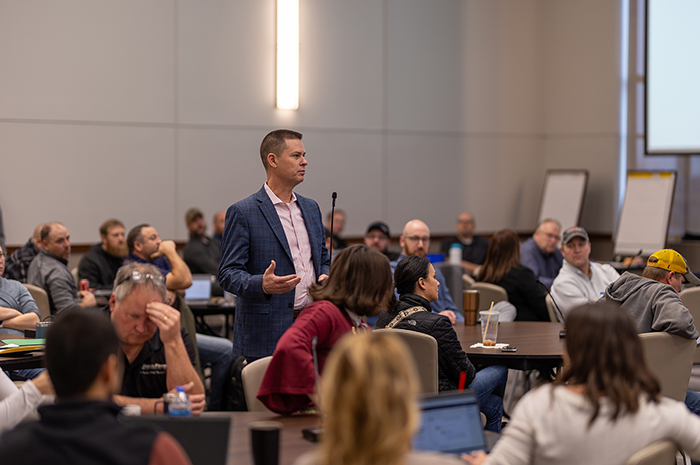Project Tundra forges ahead
Carbon capture research continues to gain momentum at Minnkota's Milton R. Young Station with the help of industry partners.
Jason Laumb admits it was a bit of a pipe dream when he and his colleagues started talking more seriously about carbon capture and storage technology for North Dakota power plants.
That was about eight years ago at a conference table inside the Energy and Environmental Research Center on the University of North Dakota campus. Laumb is a principal engineer and advanced energy systems group lead at EERC.
“It was like, my goodness, what’s it going to take?” Laumb said. “We drew out on the board the different parts we would need to make it happen – capture, oil fields, storage availability. After that meeting we went our separate ways and started developing those parts we had identified during that meeting.”
A few years later in 2016, bingo – Minnkota set its sights high by beginning the evaluation of a post-combustion carbon capture project at the Milton R. Young Station near Center, N.D. Known as Project Tundra, the venture is still in the research and feasibility stages, but it shows promise as a real-world solution to operating in a carbon-constrained world.
Building partnerships with players such as EERC and working to prioritize funding for advanced energy technologies, Minnkota hopes to bring Project Tundra to the finish line.
“It is feasible to operate,” Laumb said of carbon capture and storage. “What it comes down to is dollars and cents. What’s it going to cost to operate? What’s it going to cost to build the capture facility?
“Everything has to pencil out. Everyone has to win along that value chain. And it has to make economic sense. The preliminary indications are that, so far, it’s still making sense.”
.jpg)
Preliminary numbers put the Tundra price tag at more than $1 billion. Various tax credits from the state and the federal governments would help offset the steep cost. Laumb, who is leading the research in some of the Pre-FEED (front-ending engineering and design) work on the capture side of Project Tundra, says a better cost estimate will come later this year after the Pre-FEED work is done.
In addition to the EERC, other Minnkota partners on the project are the state of North Dakota Industrial Commission, the U.S. Department of Energy, engineers Burns and McDonnell, BNI Energy and Eagle Energy Partners.
Laumb is also the project manager for the $12.7 million Project Carbon initiative. Those research efforts involve Tundra and other carbon projects in the state.
“We are focusing on barriers,” he said. “What are the final barriers that we need to overcome to implement CO2 capture in the state of North Dakota on a plant that uses North Dakota lignite?”
Building the pilot
Later this spring, a pilot-scale test unit will be installed on Unit 2 at the Young Station. Testing will run during the summer. The pilot will include a sulfur dioxide scrubber, a CO2 absorber and a regenerator. The test system, made of stainless steel components, will capture the equivalent of a ton of CO2 per day.
With the project gaining traction, Minnkota hired one of the world’s foremost experts in CO2 technology and development in 2018. David Greeson joined the project team in October after previously serving as the vice president of development at Texas-based NRG Energy. In that role, he led the development of the Petra Nova initiative, which is currently the world’s largest post-combustion CO2 capture and enhanced oil recovery (EOR) project.
Petra Nova, located in Texas, is the only post-combustion carbon capture facility operating in the United States. Petra Nova became operational Dec. 29, 2016, on budget and on schedule.
Project Tundra is modeled after Petra Nova, which is capturing about 90% of the CO2 emitted from a 240-megawatt (MW) flue gas slipstream. The captured CO2 is then injected into mature reservoirs to release more oil.
Project Tundra aims to build on the success of Petra Nova by applying a similar, but much larger, set of technologies to Unit 2 of the Young Station. Unit 2 is a 455-MW generation facility, which has previously been retrofitted with emissions control equipment that meets or exceeds all current air quality standards.
Storage or oil recovery?
Minnkota and the EERC are researching the possibility of both carbon capture plus storage and carbon capture plus EOR. The Young Station has enough space and the right geology near the plant underground to handle straight CO2 storage.
The North Dakota CarbonSAFE initiative (Carbon Storage Assurance Facility Enterprise) is a research project investigating the feasibility of taking captured CO2 emissions from coal-fired plants, compressing it and injecting it a mile deep underground into the Broom Creek Formation in Oliver and Mercer counties, preventing the CO2 from being emitted into the atmosphere.
“The only time they would use the Unit 2 chimney once carbon capture is installed is during startup and maybe some during shutdown, where there’s an upset condition in the carbon capture. Basically, there wouldn’t be a lot of flue gas coming out of Unit 2,” Laumb said.
While Greeson heads the business development side of Project Tundra, other key players include Minnkota’s Stacey Dahl (legislative affairs), Gerry Pfau (technical manager) and Shannon Mikula (legal).
.jpg)



“I’m just excited to be part of this,” Laumb said. “If things look right and Project Tundra gets built, it will have an impact to the power industry, it will have an impact to all the power consumers Minnkota’s cooperatives have and it will have an impact to Oliver County in North Dakota. There will be a regional impact during construction and then when it’s done. If an EOR entity starts to come in and take CO2 , that will impact another part of North Dakota within that region.”
Laumb said Project Tundra would be a major industry development if it moves forward after the FEED portion of the project. The earliest Tundra construction could start would be late 2021. If it happens, Project Tundra could add more than 2,000 jobs to the area.
“There are a lot of folks in the state of North Dakota who are looking at the lead that Minnkota Power is taking on Project Tundra, and it could be a template for other folks out there with power stations to replicate,” he said.
“You’re not going to be able to do it everywhere. Not everyone has the geology. In North Dakota, we are very fortunate to have the geology for the storage side and also the oil fields for the enhanced oil recovery side. Those are two very important parts to have. You need to be able to do something with the CO2 and it has to have some value to it.”
...



